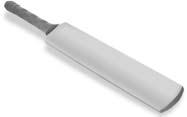
The MCC refused to use a mechanical lawnmower on the hallowed turf
This object is dedicated to Geoff Boycott, the bane of whose life, as every Test Match Special listener knows, is covered pitches, introduced into England at the end of 1980.
‘When I played for Yorkshire for the first time… We played on uncovered pitches back then. Players today can’t even comprehend what it was like – high quality bowling on a pitch which was touched by rain. When I say it was sporting, I’m using a euphemism. It was very, very challenging.’
Ask any player of a certain vintage who played in England on uncovered pitches and the answer is always the same – by heck, it was hard. Well, almost. Former Middlesex and England fast bowler Mike Selvey, whose first-class career spanned the years 1968 to 1984, commented in the pages of the Guardian (for which he writes) in 1991 that, ‘Uncovered pitches made a difference, that much is true, but it is another modern misconception that, prior to 1980, all cricket was played on green puddings.’
Just ask Jim Laker who, as we saw with our forty-ninth object, took ten wickets on a dry and dusty strip at Old Trafford in 1956.
But hasn’t cricket – faced with innovation – had a tendency to hark back to another age and imagine the game was all so much better then? When Edwin Budding patented a grass-cutting machine in 1830, it was inevitable the mechanical lawnmower would soon follow. It did, in the early 1850s, but for thirty years the MCC refused to use such a machine on the hallowed turf of Lord’s, fearing it would sully their noble game.
The invention and deployment of the lawnmower was a blessing to the likes of W.G. Grace, according to David Mortimer, author of The Oval: Test Match Cricket Since 1880. ‘W.G. began his career just as pitches were going from rough scythed grass to much finer and rolled grass on which the reliability and predictability of the ball could be enjoyed. This gave rise to a greater variety of possible shots – of all of which W.G. was able to take advantage and transform the popularity of cricket for both players and spectators.’
So there you have it. The lawnmower – far from being a mechanical monster – was of enormous benefit to cricket. The 1880s also saw the introduction of a law permitting the batting side to have the wicket rolled prior to play on the second and third day of three-day county matches. Nearly fifty years later greybeards were still grumbling about this innovation, declaring that cricket should go back to the time when rolling or sweeping the pitch was allowed only on the first day of a match. Wisden ridiculed the objections in its 1928 editorial, reminding its readers that prior to 1883 ‘there was always great keenness to get one’s opponents in overnight. Next morning bowlers were helped by worm casts and any other roughness which might have developed as the result of the weather during the night.’ In other words, matches back then were too often decided not by the batsmen and bowlers but by the elements.

The MCC refused to use a mechanical lawnmower on the hallowed turf
The clamour for a return to uncovered pitches in England reached a climax in the early 1990s when the national side lurched from one defeat to another. The great ‘cover-up’ of 1980 was to blame for the terminal decline in the English game, said a vocal minority, conveniently overlooking the fact that the previous decade had seen the likes of Gower, Lamb, Gatting and Gooch score plenty of runs.
‘I was brought up on uncovered pitches,’ the former England batsman Brian Bolus told the Independent in 1991. ‘They turn batsmen into technicians and are also essential in the learning process for bowlers. Different conditions teach batsmen how to master length and line, play up and down it, but never across.’

Next morning bowlers were helped by worm casts
Three years later the respected cricket writer John Thicknesse used his column in the London Evening Standard to declare that the ‘cover-up has cost us our place in the elite’. Only by returning to uncovered pitches, warned Thicknesse, could England restore their fortunes. ‘My guess is that a large majority of those who played or watched county cricket in the Fifties and Sixties know that the start of England’s decline was the switch to covered pitches in 1981.’
It was a fatuous theory, and Thicknesse’s call for a return to covered pitches was dismissed by the players. ‘Uncovered wickets would make the game a lottery,’ said Derbyshire captain Kim Barnett, while Tim Curtis of Worcestershire (also the then chairman of the Cricketers’ Association) explained: ‘I know that uncovered pitches might add a bit of spice but I am still not in favour. They would involve an element of luck with the toss.’
Nowadays there are fewer calls for pitches in England to be uncovered. The generation who played the game in the 1950s and ’60s is thinning, plus England are winning – so covers can’t be all bad. Only Geoffrey continues to pine for the days when pitches were uncovered and corridors were more uncertain.